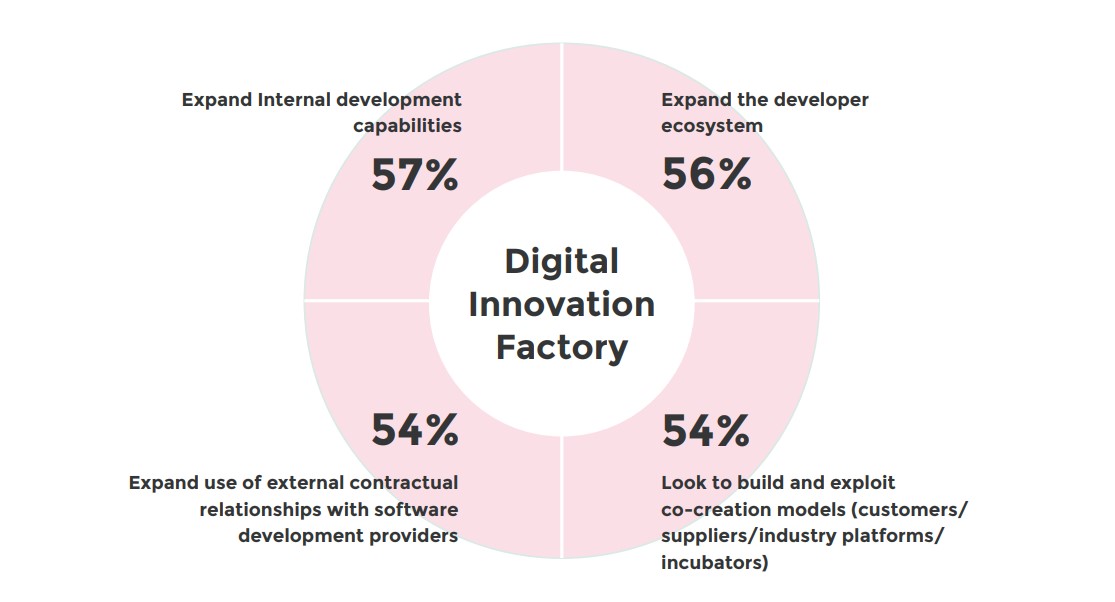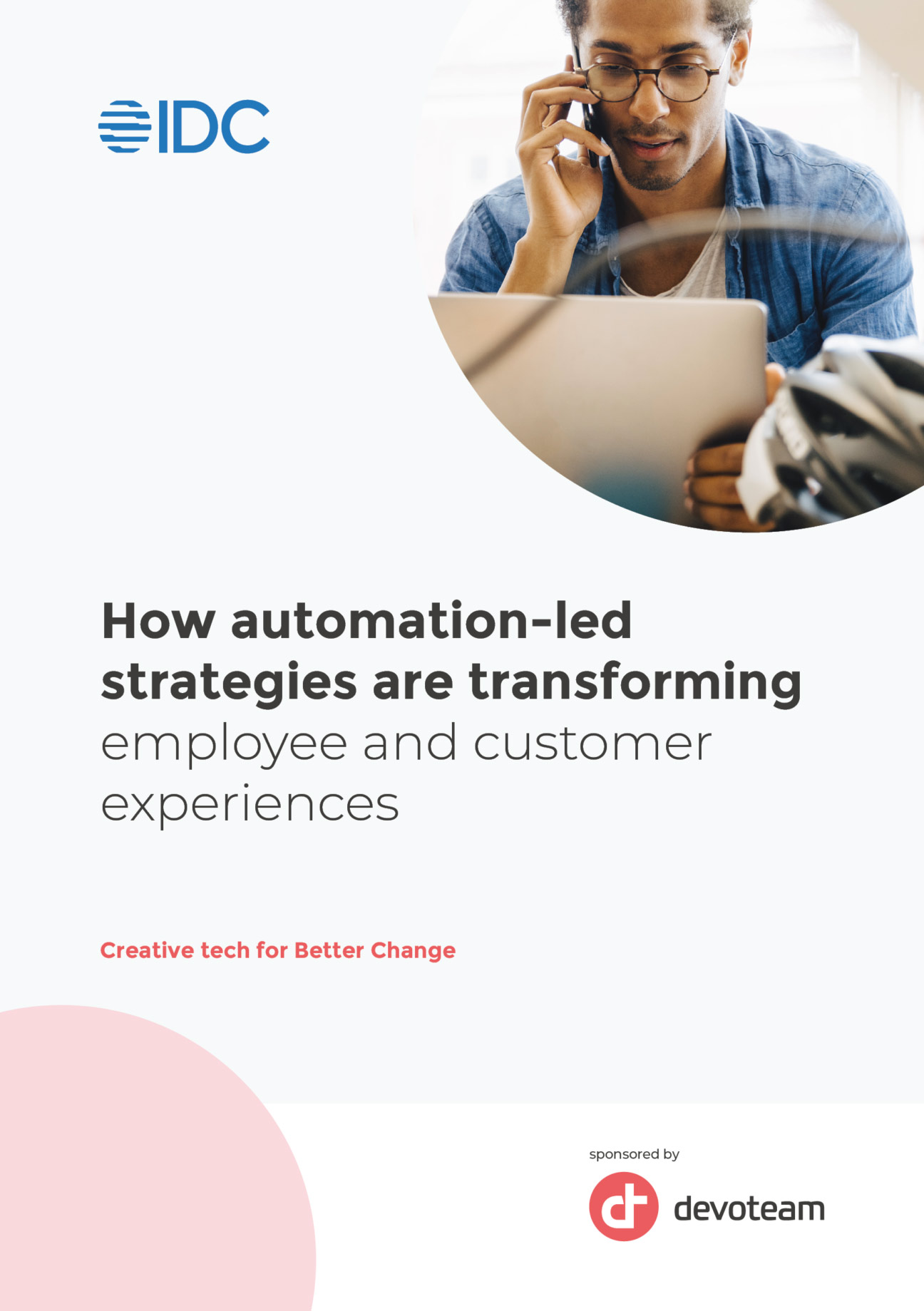Chapter 1: CIOS are rethinking their role as digital innovation co-creators
How does your company plan to approach software development and delivery to drive digital innovation?

CIOs cannot undertake strategic Wholesale transformation without a digital-first business model and more reliable and automated practices.
Digital innovation and automation go hand in hand
Digital innovation is an imperative for success, but CIOs in Europe are at different stages in their ambitions to deliver digital innovation across the business. By this we mean creating new digital platforms and applications that support the platformbased digital enterprise. Over half are seeking to expand their internal development capability and developer ecosystem and looking to exploit co-creation models with that ecosystem.
However, one in four CIOs in Europe are also seeking to expand their use of external contractual relationships. These CIOs recognize that they lack the internal skills to execute on their ambitions and need access to best of breed technologies, and access to the right talent and skills. This is particularly important since there is an explosion of tool chain complexity, from cloudbased platforms to discrete digital apps. CIOs and LOB executives must shift from buying and extending software from a relatively finite number of vendors to sourcing software components and services from multiple sources.
CIOs should consider a digital innovation factory approach as they look to scale out from initial projects
IT organizations need to move from an ad-hoc, project-by-project approach to innovation and automation to creating a formal process with structure, governance and controls to help scale development and adoption.
Forward-thinking CIOs are now bringing their ecosystem partners together to create digital product “innovation factories“ and automation centers of excellence (CoE). These innovation factories must align human and technology resources and produce software and software-enabled products continuously. They must also establish practices to seek out opportunities for innovation and automation within the business, to have a continual pipeline to build and support adoption within the business. To achieve scale, reuse and automation become critical. To reap the benefits of enterprise scale, organizations must focus on what they can reuse and where. For many, this is a tech responsibility, as the end goal or requirement is to make these capabilities selfservice and automatable.
Agile and DevOps practices go hand in hand with digital innovation and automation. The challenge for CIOs is to ensure that enterprisescale DevOps is achievable. To enable DevOps to become business as
usual, organizations must rethink business alignment and governance processes, but also consider tool complexity, culture, organizational goals, and sourcing models. As digital solutions become increasingly
complex and are created by workers both inside and external to the organization, CIOs will have to find ways to manage development processes, especially agile ones, to keep all parties aligned and in sync.
The Digital Innovation Factory becomes a central hub to unite innovations in digital platforms, apps. and services, with a view to scaling across the business. Enterprise automation will play a central role.

Chapter 2: Volatility, uncertainty, complexity and ambiguity (VUCA) is driving a rapid shift to Business Automation
Never has the term VUCA been as meaningful as today, with the pandemic still impacting business and society on unprecedented levels.
COVID-19 has exposed many organizations in their failure to embrace automation.
In conversations with IDC, many organizations admit they had broken or disrupted supply chains, delays and failure to execute orders due to new distributed working, and security breaches due to rapid changes to IT rules and actions. These organizations perceive automation as the cornerstone of digital resilience and customer centricity.
Organizations across every industry are being forced to evaluate their business operations from multiple perspectives and look for ways to make their businesses more resilient to both unpredictable environments and financial stresses.
Automation that drives out manual tasks, reduces errors, and processes tasks many times faster than humans is more reliable and resilient in the face of disruption.
Another repercussion is that the insourcing of teams will accelerate, because organizations will need to retain greater control of their automation investments to ensure that they are aligned to the new strategic imperatives of agility and resilience. For instance, systems and processes need to be able to increase adaptability for seasonal fluctuations. Controlling these levers of adaptation will need to be in the hands of the business users.
Automation has become the top priority to support organizational ambitions to deliver software-based digital innovation.
- Crisis recovery: React-Recalibrate-Reignite
IDC’s research shows that automation is the single most important approach to navigate through each of the stages to a digital future.
- Driving business resilience in newly dispersed customer service, support, finance and operations functions — specifically through automation — is now at the top of even more executives’ agendas.
Automation has become the top priority to support organizational ambitions to deliver software-based digital innovation.
- Top of the list is IT where 86% of organizations indicate planned investments in automation; next is customer service and support (75%); followed by marketing (74%), R&D (72%), sales (71%), finance (70%) and business operations (69%)
Investments Planned in Automation by Business Function in 2021
Investments Planned in Automation by business Function in 2021

